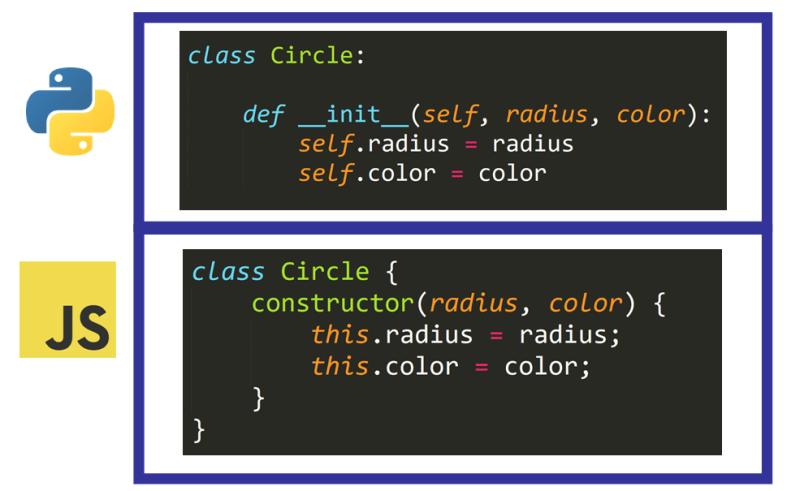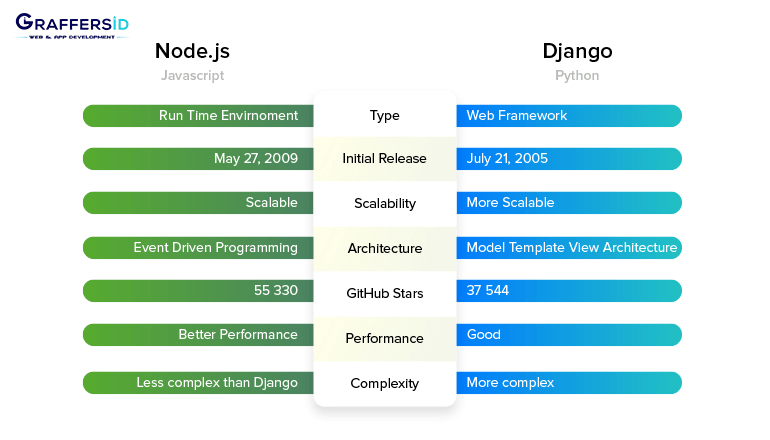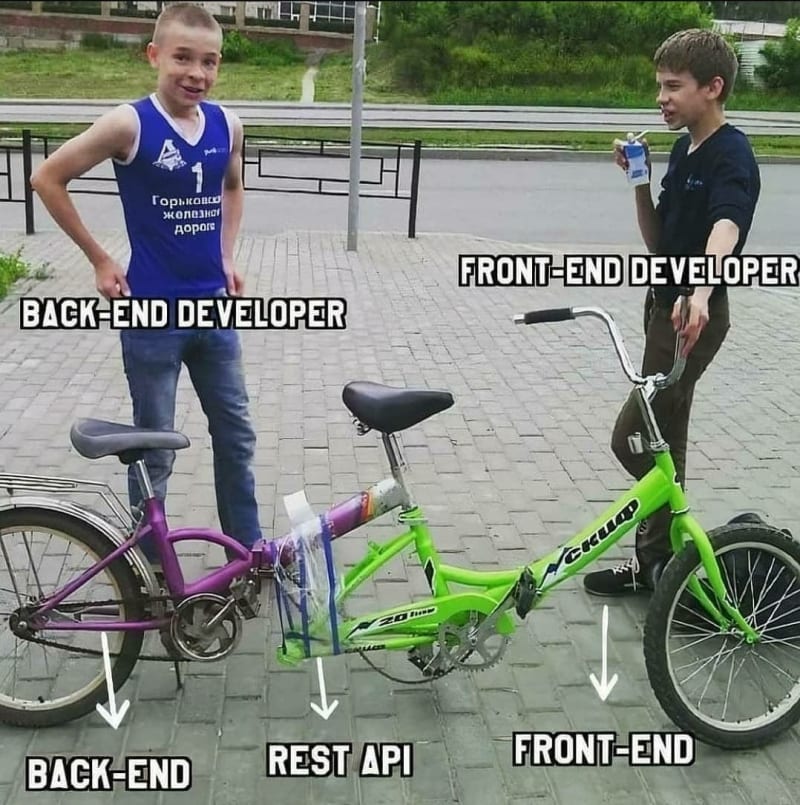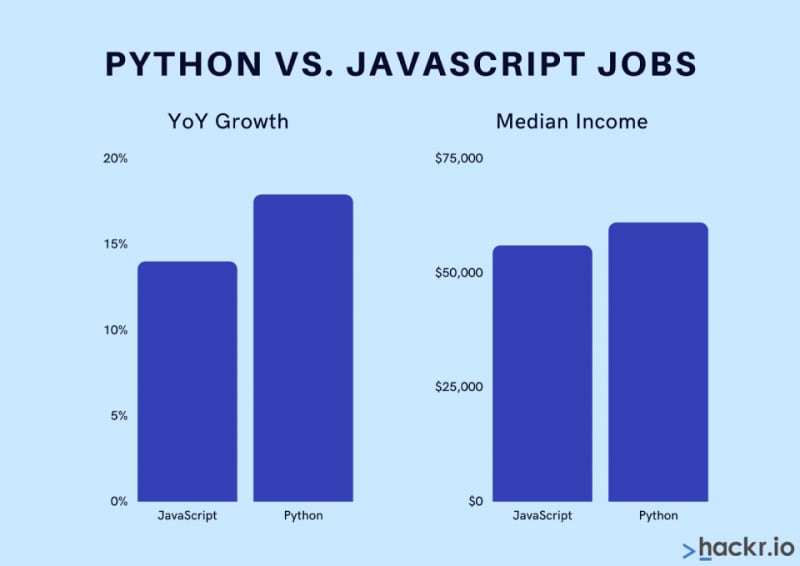Two of the most commonly used programming languages out there are JavaScript and Python. They are both very versatile and popular, and are used a lot in software development. Despite their similarities, though, these two languages possess distinct traits, making them better suited for different needs. In this blog, we'll be exploring the major differences and commonalities between JavaScript and Python to help you decide which one is right for you.
Syntax: The Language of Expression
Python is known for its readability and ease of use. Its code can be likened to pseudo-code due to its similarity to natural language. With minimal use of symbols and clear indentation, Python is a great language for both beginners and experienced developers. The emphasis on code readability enforced by "Zen of Python" principles enables the creation of clean and maintainable code.
The choice between Python and JavaScript often depends on an individual's preference and the project requirements. Python is favored in scenarios where readability and ease of understanding are essential, whereas JavaScript is preferable for web development and making interactive web applications. Python has a relatively straightforward syntax, while JavaScript has a more complex one, making use of curly braces, semicolons, and many symbols. JavaScript's dynamic typing offers flexibility, although this can be a double-edged sword when not handled correctly.
Ecosystem: Where Do They Thrive?
Python's ecosystem is an important factor in its success. It offers a wide selection of libraries and frameworks, making it a great choice for data science, machine learning, scripting, web development, and even game development. Libraries like NumPy, pandas, and scikit-learn make Python a great tool for data science and machine learning projects. Its simplicity also makes it a great option for web development (Django, Flask) and game development (Pygame).
JavaScript is a key player in web development. It is the driving force behind the front-end of most sites, and can be used to construct server-side applications with Node.js. The modern frameworks React, Angular and Vue.js have enabled developers to generate dynamic and interactive user interfaces, and with the immense npm registry, a huge array of open source packages are available to deal with the varied tasks associated with development.
Typing: Dynamic vs. Dynamic
JavaScript and Python have different typing systems. With JavaScript, variable types are determined at runtime, allowing for more compact coding but potentially introducing unforeseen problems if not handled properly. Python, on the other hand, is statically typed, meaning variables must be declared with a specific type.
On the other hand, Python is dynamically typed as well, where variable types are also determined at runtime. In Python, you do not need to declare the type of a variable explicitly. Python's dynamic typing allows for greater flexibility and ease of use, but it may also lead to unexpected runtime errors if variable types are not handled correctly.
To provide more type safety and catch errors at compile-time, Python introduced optional type hints with the "Type Hinting" feature. Type hints allow developers to annotate their code with expected variable types, enhancing code reliability and maintainability. This feature was introduced in Python 3.5 and is especially useful when working on larger codebases or collaborating with other developers.
In summary, both JavaScript and Python are dynamically typed languages, but Python has the option to use type hints for improved code quality and error detection during development.
Performance: The Need for Speed
When it comes to performance, JavaScript and Python exhibit significant differences. JavaScript is known for its speed and efficiency, especially in web development. Browsers are optimized to execute JavaScript quickly, making it the ideal choice for creating responsive and interactive web applications. This performance advantage is further augmented by Just-In-Time (JIT) compilers in modern JavaScript engines like V8 (used in Chrome) and SpiderMonkey (used in Firefox). These compilers translate JavaScript code into machine code, drastically improving execution speed.
In contrast, Python's performance can be a bit more sluggish, particularly in CPU-intensive tasks. The Global Interpreter Lock (GIL) in Python can hinder multi-threading performance in certain scenarios. However, for many applications, such as web development, data analysis, and scripting, Python's performance is more than adequate. Additionally, Python offers tools like Cython and PyPy that can boost performance in specific cases. If raw performance is a critical factor for your project, JavaScript may have the edge, but Python's performance is often sufficient for most applications.
Learning Curve and Education
The ease of learning a programming language is a crucial factor, especially for beginners. Python's straightforward and readable syntax, often compared to pseudo-code, makes it an excellent choice for those new to programming. Its emphasis on code readability and indentation fosters good coding practices and reduces the likelihood of syntax errors. This ease of learning has made Python a popular choice for educational institutions, where it is frequently used to introduce programming concepts.
JavaScript, with its dynamic nature and sometimes intricate behavior, may present a steeper learning curve for newcomers. However, it offers instant gratification for web development enthusiasts, as they can quickly see their code in action on web browsers. JavaScript's ubiquity on the web makes it a valuable skill for aspiring front-end developers.
Ultimately, the learning curve is a subjective experience that varies from person to person. Your prior programming experience and your project's requirements will influence which language you find more accessible and suitable for your needs.
Concurrency and Parallelism: Handling Concurrent Tasks
When it comes to managing concurrent tasks and parallelism, JavaScript and Python have different approaches. JavaScript's event-driven, single-threaded nature makes it particularly suited for handling asynchronous operations, which are common in web development. The use of callbacks, promises, and async/await syntax allows JavaScript developers to efficiently manage tasks like fetching data from a server, handling user interactions, and updating the user interface without blocking the main thread.
Python, by contrast, has a Global Interpreter Lock (GIL), which limits the execution of multiple threads simultaneously within a single process. This means that Python's standard CPython interpreter does not take full advantage of multi-core processors for CPU-bound tasks. However, Python developers can use multiprocessing to leverage multiple processes for parallelism, which can be beneficial for CPU-intensive tasks. Additionally, Python's asyncio library provides a framework for managing asynchronous operations, somewhat akin to JavaScript's event loop, although with some differences in implementation.
The choice between JavaScript and Python for concurrency and parallelism largely depends on the nature of your application. If you are working on a web application that requires efficient handling of many concurrent I/O operations, JavaScript's event-driven model is a natural fit. For CPU-bound tasks that can benefit from parallelism, Python's multiprocessing can be employed.
Error Handling: Gracefully Dealing with Mistakes
Error handling is a crucial aspect of programming, as it ensures that your code can gracefully deal with unexpected issues. In JavaScript, errors are typically handled using try-catch blocks, which allow developers to capture and respond to exceptions during runtime. JavaScript's dynamic typing can sometimes lead to unexpected runtime errors, making effective error handling essential.
Python, on the other hand, encourages a strong focus on error handling through its explicit exceptions system. Python developers are encouraged to catch specific exceptions using try-except blocks, promoting more robust and predictable code. Python's exception hierarchy and clear error messages make it easier to identify and address issues during development.
While both languages provide mechanisms for error handling, Python's approach tends to result in more structured and predictable error management, which can help prevent unexpected issues in production code.
Interoperability: Bridging the Gap
In many real-world applications, you may find yourself needing to use both JavaScript and Python within the same project. JavaScript is the primary language for client-side web development, while Python often powers server-side logic and data processing. Fortunately, both languages offer solutions for interoperability.
For server-side integration, Node.js enables the execution of JavaScript on the server, allowing developers to build full-stack applications with a single language. This unified approach simplifies code sharing and reduces context switching between languages.
Python also offers several tools and libraries for integrating JavaScript. For example, you can use Python's subprocess module to execute JavaScript code from within a Python script. Additionally, frameworks like Flask and Django can serve as backends for applications that use JavaScript on the front end.
When deciding which language to use for a project that requires interoperability, consider factors such as your team's expertise, existing codebase, and specific requirements.
Tooling and Development Environment: Building Your Workspace
The development environment and available tools can significantly impact your productivity and coding experience. JavaScript and Python each have their set of tools and development ecosystems.
JavaScript developers often use integrated development environments (IDEs) like Visual Studio Code (VSCode), which offers excellent support for JavaScript, TypeScript, and various web development technologies. There are also numerous extensions and plugins available to enhance the development experience, making VSCode a popular choice.
Python developers have a wide selection of IDEs to choose from as well. PyCharm, developed by JetBrains, is a powerful IDE specifically designed for Python, offering features like code completion, debugging, and support for various web frameworks like Django and Flask. However, Python's simplicity also makes it easy to code using lightweight text editors like Sublime Text or even Jupyter Notebooks for data science tasks.
When selecting a development environment, consider factors such as your familiarity with the tools, the project's requirements, and the community support available for your chosen setup.
Community and Collaboration: Nurturing Innovation
The power of a programming language's community cannot be overstated. It's not just about support; it's about fostering innovation and collaboration. Both JavaScript and Python have vibrant communities, but they differ in terms of their areas of focus and contributions.
JavaScript's community primarily revolves around web development, with thousands of developers working together to improve front-end and back-end technologies. This collaborative spirit has led to the creation of numerous open-source libraries and frameworks that enhance the web development landscape. The constant evolution of JavaScript and the browser ecosystem ensures that developers are always pushing the boundaries of what can be achieved on the web.
Python's community, while also passionate about web development, has a broader scope. Python's popularity in fields such as data science, scientific computing, and automation has led to the development of specialized libraries and tools that enable groundbreaking research and applications. The community's emphasis on readability and clean code contributes to Python's reputation as a language that encourages best practices and maintainability.
When choosing between JavaScript and Python, consider where you want to contribute and collaborate. Are you drawn to the dynamic world of web development or the data-driven realms of data science and AI? Understanding the focus of each community can guide your decision.
Job Roles and Specializations
The job market offers a plethora of roles for both JavaScript and Python developers, and each language comes with its own set of specializations.
JavaScript developers can find roles as front-end developers, back-end developers (using Node.js), full-stack developers, mobile app developers (using frameworks like React Native), and even in emerging fields like serverless computing. Front-end developers specialize in creating engaging user interfaces, while back-end developers focus on server-side logic and APIs. Full-stack developers bridge both worlds, while mobile app developers target mobile platforms. Serverless computing, powered by services like AWS Lambda, allows developers to build scalable, event-driven applications.
Python developers have a wide range of roles as well. Data scientists and machine learning engineers use Python extensively for data analysis, modeling, and AI development. Web developers often work with Python to build server-side applications, with specializations in frameworks like Django (full-stack) or Flask (microservices). Python also plays a significant role in automation and scripting, making it valuable for DevOps and infrastructure tasks.
Your choice of specialization should align with your interests and career goals. Consider where you'd like to excel and the kind of work that excites you the most.
Ethical Considerations and Social Impact
In the realm of technology, ethical considerations and social impact are becoming increasingly relevant. The choices you make as a developer can have far-reaching consequences on society, and both JavaScript and Python play roles in this context.
JavaScript is the backbone of the modern web, which means that web developers using JavaScript have a responsibility to ensure that their applications are secure, accessible, and respectful of user privacy. Ethical concerns related to tracking, data collection, and user consent are essential considerations in web development. As a JavaScript developer, you can contribute to a safer and more ethical online environment by following best practices and staying informed about evolving ethical standards.
Python, with its extensive use in data science and AI, raises ethical questions related to algorithms, bias in machine learning models, and data privacy. Developers working with Python in these fields must be conscious of the potential societal implications of their work and strive for fairness, transparency, and ethical use of data.
Choosing a language can also involve aligning your values with the ethical considerations associated with its use. Both JavaScript and Python communities are actively discussing and addressing these issues, providing opportunities for developers to engage in responsible development practices.
Accessibility and Inclusivity
Creating software that is accessible to all users, regardless of their abilities, is a crucial aspect of modern development. Both JavaScript and Python communities have made efforts to promote accessibility and inclusivity.
JavaScript developers, especially those working on web applications, are encouraged to follow web accessibility standards and practices. This ensures that people with disabilities can access and use web content effectively. Libraries and frameworks often provide accessibility features and guidance to make it easier for developers to create accessible web applications.
Python's readability and simplicity make it an accessible language for beginners and experienced developers alike. Python's community values inclusivity and strives to make the language welcoming to individuals from diverse backgrounds. Efforts are made to provide documentation and resources that cater to learners with varying levels of expertise and accessibility requirements.
Consider your commitment to accessibility and inclusivity when choosing a language and community to be a part of. Both JavaScript and Python offer opportunities to contribute to creating technology that is accessible and welcoming to everyone.
Personal Projects and Passion Projects
Beyond career considerations, programming languages like JavaScript and Python are excellent choices for personal and passion projects. These languages empower you to bring your creative ideas to life, whether it's building a personal website, creating a mobile app, automating daily tasks, or exploring your interests through data analysis and visualization.
JavaScript's versatility and prevalence in web development make it an excellent choice for building personal websites, portfolios, and interactive web applications. You can experiment with front-end frameworks and libraries to enhance your projects and showcase your skills.
Python's ease of use and extensive libraries make it a fantastic language for hobbyists and tinkerers. You can build games, automate tasks, analyze data, or explore topics like machine learning and artificial intelligence in your personal projects.
Your choice between JavaScript and Python for personal projects should align with your interests and creative aspirations. Whether you're driven by web development, data exploration, or any other personal endeavor, both languages offer a wealth of opportunities for personal growth and satisfaction.
The Joy of Coding: Finding Your Passion
Ultimately, your journey as a developer should be guided by your passion and interests. The joy of coding comes from solving problems, building solutions, and creating something meaningful. Whether you choose JavaScript or Python, or both, the key is to embrace your passion and let it drive your learning and development.
Your choice of language should be a reflection of your goals, values, and aspirations as a developer. Both JavaScript and Python offer exciting and rewarding paths, and there is no shortage of opportunities to make a positive impact on the world through your coding endeavors.
So, as you embark on your coding journey, remember that the world of software development is vast, and there are countless adventures awaiting you, whether you choose JavaScript, Python, or both. Enjoy the thrill of discovery, the satisfaction of problem-solving, and the continuous growth that comes with being a developer.
Industry Adoption and Case Studies
To gain a deeper understanding of the real-world impact of JavaScript and Python, it can be helpful to explore industry adoption and case studies.
JavaScript's widespread use in web development is evident in the success stories of companies like Facebook (using React), Google (using Angular), and Netflix (using Node.js for server-side rendering). The speed and interactivity of JavaScript-powered web applications have transformed user experiences on the internet. Learning from these industry leaders can provide insights into how JavaScript is leveraged for competitive advantages.
Python's impact is equally significant, particularly in data-driven industries. Organizations like Netflix and Spotify use Python for recommendation algorithms, while institutions like NASA rely on it for scientific computing and data analysis. Python's role in data science is further exemplified by its extensive use in companies like Google, Amazon, and Microsoft. Case studies in these domains highlight Python's ability to solve complex problems and drive innovation.
Exploring industry adoption and real-world case studies can help you appreciate the practical applications of both languages and inspire you in your programming journey.
Web Development: Front-End vs. Back-End
JavaScript's dominance in web development extends to both front-end and back-end development. Front-end web development focuses on creating the user interface and user experience (UI/UX) of a website or web application. JavaScript, along with HTML and CSS, forms the core technology stack for front-end development. Popular JavaScript frameworks like React, Angular, and Vue.js empower developers to build interactive and responsive user interfaces.
Python, while not typically used for front-end development, has a strong presence in back-end web development. Frameworks like Django and Flask are widely adopted for building robust, scalable, and secure web applications. These frameworks follow the Model-View-Controller (MVC) architecture and come with built-in features for handling databases, user authentication, and more.
The choice between JavaScript and Python in web development depends on whether you're focusing on the front-end or back-end, or if you're opting for a full-stack approach. Understanding the distinct roles of these languages in web development can guide your decision.
Deployment and Hosting: Taking Your Code to the World
Once your code is ready for production, you need to consider deployment and hosting options. Both JavaScript and Python offer various solutions for this crucial phase.
JavaScript applications, especially front-end web apps, can be deployed to content delivery networks (CDNs) or cloud platforms like AWS, Azure, or Netlify. Node.js allows you to host server-side JavaScript applications on platforms like Heroku, AWS Lambda, or Google Cloud Functions.
Python web applications can also be hosted on popular cloud platforms like AWS, Google Cloud, and Azure. Platforms like Heroku and PythonAnywhere provide simple hosting solutions for Python web applications. Additionally, Python's robust support for containerization with Docker allows for flexible deployment options.
Choosing the right deployment and hosting solution depends on your application's requirements, scalability needs, and budget constraints. Both languages offer a wide range of options to suit various scenarios.
Trends and Industry Adoption
Staying informed about the current trends and industry adoption of programming languages can be crucial for career growth and job prospects.
JavaScript continues to dominate the web development landscape, with its frameworks like React, Angular, and Vue.js gaining widespread adoption. Progressive web applications (PWAs), single-page applications (SPAs), and serverless computing are some of the notable trends in the JavaScript ecosystem.
Python, meanwhile, has seen a surge in popularity, especially in fields like data science, machine learning, and artificial intelligence. Libraries like TensorFlow and PyTorch have solidified Python's position as a go-to language for AI and deep learning projects. Python's simplicity and versatility make it an attractive choice for rapid development and prototyping.
Keep an eye on industry trends and the evolving demands of the job market to align your skills with emerging opportunities. The ability to work with both JavaScript and Python can be a valuable asset, allowing you to adapt to a variety of projects and industries.
Job Market and Career Prospects
The job market for both JavaScript and Python developers is thriving. JavaScript's dominance in web development ensures a steady demand for front-end and back-end developers skilled in JavaScript and its associated frameworks. Python's versatility has led to an explosion of opportunities in fields such as data science, machine learning, and automation. Python's presence in web development also creates a demand for Python web developers.
When considering your career prospects, think about your interests and long-term goals. If you're passionate about web development and building interactive user interfaces, JavaScript may be your preferred path. Conversely, if you're drawn to data analysis, machine learning, or scientific computing, Python might be your language of choice. Keep in mind that learning both languages can open doors to a wide range of job opportunities and make you a well-rounded developer.
Community and Support
Both JavaScript and Python boast thriving communities and ample resources for developers. JavaScript's community is particularly vast, given its prominence in web development. Online forums, documentation, and tutorials abound, making it easy to find help and guidance for JavaScript-related projects. Python, with its diverse ecosystem, is also well-supported, with a wealth of documentation, active forums, and a strong presence in the fields of data science and artificial intelligence.
In terms of job opportunities, both languages offer a multitude of options. Python's stronghold in data science and machine learning has led to a surge in demand for Python developers. JavaScript, as the backbone of web development, is equally in high demand, with front-end and back-end roles abundant in the job market.
Conclusion
JavaScript and Python are both incredibly powerful options when it comes to programming. JavaScript offers speed and efficiency for web development, while Python's libraries and ease-of-use make it great for data science and automation. Selecting between the two depends on the project, personal tastes, and development goals. No matter which you pick, both languages will provide opportunities in the ever-evolving software industry.











Top comments (0)